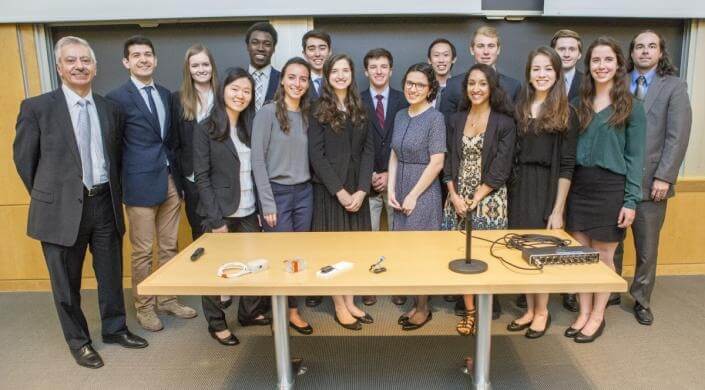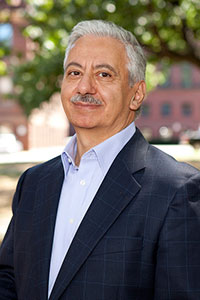News
A team of students used engineering design principles to identify spaces across campus that enable effective communication for hard-of-hearing individuals. (Photo by Eliza Grinnell/SEAS Communications.)
Walk into Harvard’s Leverett House dining hall during the dinnertime rush and it is nearly impossible to hear anything beyond the chatter of hungry students and the clatter of plates and silverware.
Noisy public spaces like this often double as meeting locations for undergraduates collaborating on course assignments, and they pose extra challenges for students who are deaf or hard of hearing.
Focusing on this widespread accessibility issue, students in the John A. Paulson School of Engineering and Applied Sciences (SEAS) course Engineering Problem Solving and Design (ES 96) worked with University Disability Services on a semester-long project to identify spaces across campus that enable effective communication for hard-of-hearing individuals. In ES 96, students work as a team with a client to define an open-ended, complex problem, create a systems analysis, and propose a solution.
Almost 15 percent of children, teens, and young adults have some degree of hearing loss, according to the Centers for Disease Control, making it the third most prevalent chronic condition in the U.S.
Despite those statistics, lecture halls and collaborative spaces are biased toward hearing ability, said Daniel Galindo-Navarro, S.B. ’18, an electrical engineering concentrator. Assistive devices such as hearing aids are often ineffective in crowded spaces because they amplify all sounds, including background noise.
“Something we wouldn’t even think twice about, like working in a dining hall when many people are talking at the same time, and the ease with which we identify speakers and parse auditory information, is much harder for someone who uses hearing aids or cochlear implants,” said Galindo-Navarro. “One objective of this project was to raise awareness of the issues faced by individuals who are hard of hearing.”
The team focused on two solutions. First, they created a web application, called SweetSpot, which uses real-time acoustic monitoring to help students find collaborative workspaces based on their preferred level of ambient noise. Second, they developed a model to quantify speech intelligibility in classrooms.
The students utilized WIFI-enabled audio recording hardware to gather data they used to develop a model to quantify speech intelligibility in classrooms. (Photo by Eliza Grinnell/SEAS Communications.)
For SweetSpot, the students studied acoustics in certain classrooms and common spaces by installing wifi-enabled microphones that broadcast real-time sound data to a website. The application calculates average sound intensity over time and incorporates that data into a user-friendly interface to provide room suggestions based on user inputs of preferred days, times, and noise levels.
“Our goal with SweetSpot is to provide a lot more useful acoustic data about rooms on campus over time, so students will be better able to select rooms that actually accommodate their needs,” said Humphrey Obuobi, A.B. ’18, a biomedical engineering concentrator. “We want the user to be at the center of this tool. Everything we designed was based on the interviews we conducted and the research we performed.”
The second project component, quantifying how easy it is to hear sounds in classrooms, was especially challenging because this information is often subjective. Students created a computational model that uses sound reverberation time, a measurement of echo, and a weighted average of the speech comprehensibility recorded at different points within a room, to yield a speech intelligibility rating.
The data show which of two classrooms presents an environment where a lecturer would be easier to hear in any seat.
“If a student can’t hear the professor well during a lecture, he or she won’t be able to participate in class and, ultimately, may not perform as well on tests,” said Jenny Horing, S.B. ’18, a mechanical engineering concentrator. “People who are hard-of-hearing already struggle with this, so compounding that issue with a room that is acoustically unfriendly makes it that much harder for them to keep up with their classmates.”
The students hope to apply the speech intelligibility index to more classrooms and provide recommendations the Registrar could incorporate into classroom assignment decisions.
“This year’s topic was very thought-provoking and difficult. If you examine the response to hearing loss, you will see a wide variety of responses are needed,” said Michele Clopper, director of University Disability Services. “This project is a step towards giving individuals a means to select spaces that would best meet their hearing needs.”
Fawwaz Habbal, Executive Dean for Education and Research, who co-taught the course with Christopher Lombardo, Associate Director for Undergraduate Studies in Engineering Sciences, was impressed by the students’ collaboration and careful analysis.
“Considering the root causes of complicated engineering problems is an important lesson for these students,” he said. “Engaging in a problem like this, which has a real impact on the lives of individuals, will hopefully inspire these students to think about the people behind the problems they will solve in their future careers.”
Ultimately, the students hope their ES 96 project raises awareness among their peers of the challenged faced by hard-of-hearing individuals at Harvard. (Photo by Eliza Grinnell/SEAS Communications.)
Topics: Academics
Cutting-edge science delivered direct to your inbox.
Join the Harvard SEAS mailing list.
Scientist Profiles
Fawwaz Habbal
Senior Lecturer on Applied Physics
Press Contact
Adam Zewe | 617-496-5878 | azewe@seas.harvard.edu




